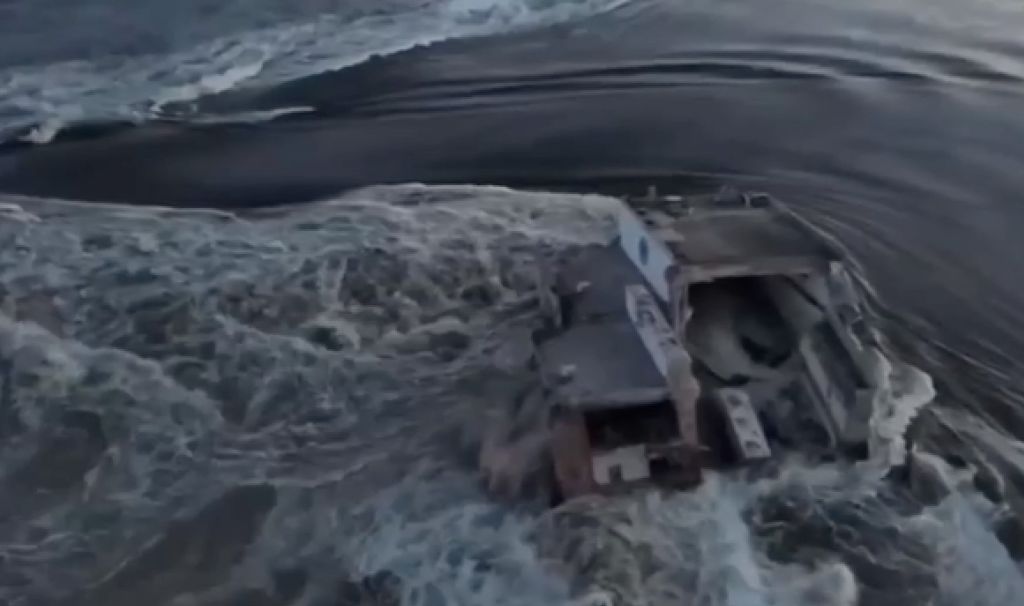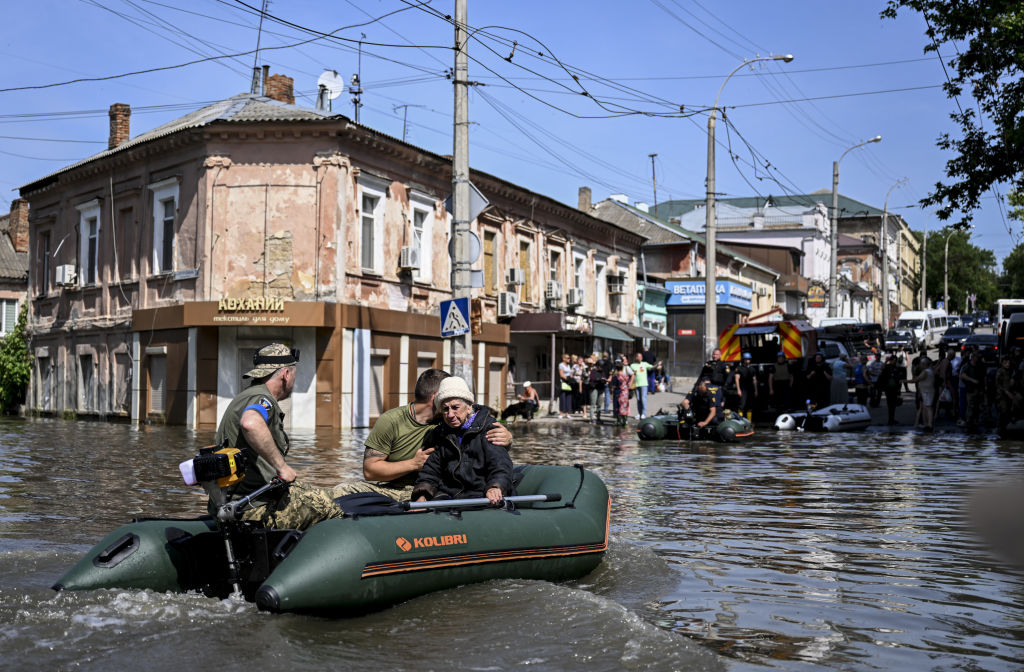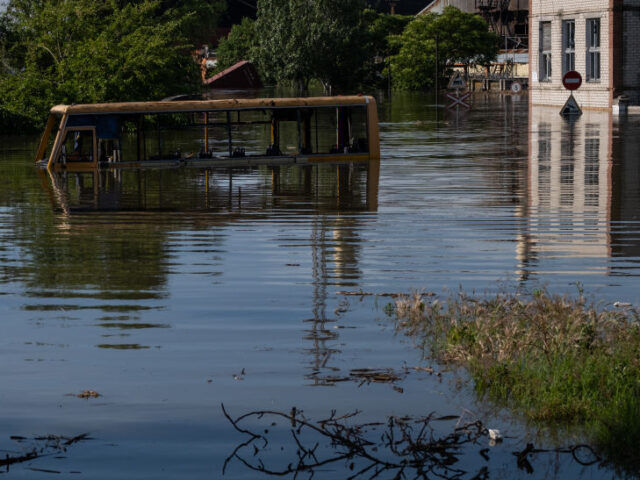KYIV, Ukraine (AP) – Russian occupation authorities vastly and deliberately undercounted the dead in one of the most devastating chapters of the 22-month war in Ukraine – the flooding that followed the catastrophic explosion that destroyed the Kakhovka Dam in the southern Kherson region.
The AP’s reporting focused on Oleshky, one town in the vast area flooded by the dam. Health workers and others who were in Oleshky told The Associated Press that Russian authorities hid the true number of dead by taking control of the issuance of death certificates, immediately removing bodies not claimed by family, and preventing local health workers and volunteers from dealing with the dead, threatening them when they defied orders. Still afraid, many Oleshky residents and health workers declined to speak, fearing reprisal. The AP´s investigation is based on the accounts of those who did, most of whom spoke on the condition of anonymity or on condition only their first names be used, fearing reprisal from Russia on family members still in occupied territory.

KHERSON, UKRAINE – JUNE 6: (—-EDITORIAL USE ONLY – MANDATORY CREDIT – ” ZELENSKYY SOCIAL MEDIA ACCOUNT / HANDOUT” – NO MARKETING NO ADVERTISING CAMPAIGNS – DISTRIBUTED AS A SERVICE TO CLIENTS—-) A screen grab captured from a video shows the Kakhovka Hydroelectric Power Plant after a blast occurred in plant which is in the Russian-controlled part of Ukraine’s Kherson on June 6, 2023. The explosion unleashed floodwaters across the war zone. (Photo by Zelenskyy Social Media Account / Handout/Anadolu Agency via Getty Images)
Here are the key takeaways from the investigation:
In the critical first hours after the dam collapse on June 6, occupation authorities downplayed the consequences, leading many Oleshky residents to believe they would not be affected. This later contributed to the high death toll.
Russia said 59 people drowned in the territory it controls. The AP investigation found the number is at least in the hundreds in Oleshky alone, among the most populous in flood affected areas with around 16,000 residents at the time, according to Ukrainian officials.
Health workers said they believe 200-300 people died in the town. Many are still missing, their bodies likely still trapped in homes.
A volunteer, who feared reprisal and spoke on the condition of anonymity, said she, her husband and two neighbors picked up at least 100 bodies during the floods. These were taken to the central cemetery in Oleshky and buried in graves 1 meter (3 feet) deep. The volunteer was later threatened by Russian occupation authorities and forbidden from collecting bodies.
‘Russian Terrorists’: Civilians Evacuated as Major Ukraine Dam Blown Uphttps://t.co/3UvsLvXABP
— Breitbart London (@BreitbartLondon) June 7, 2023
Svitlana, a nurse at the Oleshky District Multidisciplinary Hospital, the city´s main primary health center, said she saw the flood waters rise toward her home the afternoon of June 6 as she was walking her dog. By the next morning, two-floor homes would be inundated, its residents trapped on the roof.
Chaos ensued as volunteers began rescuing people using their own resources. For the first three days, occupation authorities were nowhere to be seen, local residents, volunteers and health workers said. Many sought help from health workers in the hospital where Svitlana worked, which by that time had become a refuge for those forced out from flooded areas.
The dead began appearing. Bloated bodies were seen floating. As waters receded allowing residents to check on relatives, more were found trapped in the mud under collapsed homes.
Health workers said occupation authorities returned around June 9, three days after the flooding. They came with strict orders prohibiting doctors in the hospital from issuing death certificates for drowning victims – but not for those who died of natural causes.
This was a departure from protocol followed by doctors since Oleshky was occupied by Russian forces in March 2022. Doctors were permitted to issue death certificates, and did so in Russian and secretly in Ukrainian to keep Kyiv´s records up to date.
Russia Blew Up The Dam And We Have Proof, Says Ukraine as it Publishes New Picturehttps://t.co/UzwwfgWSOS
— Breitbart London (@BreitbartLondon) June 19, 2023
By prohibiting doctors from issuing death certificates for the drowned, occupation authorities essentially took away doctors´ authority and ability to document the number of dead. Svitlana, who oversaw record-keeping for the drowned, said Russian police verbally issued the order, and did not provide an official written statement.
Police came to the hospital daily to copy the hospital’s death certificates, making sure none were for drowning victims.
Those with dead relatives were told to go to forensic centers in other districts, where doctors selected by occupation authorities were responsible for signing death certificates. The bodies could not be buried without the document.
Residents and health workers were told to call police if they saw a dead body. Trucks belonging to the Russian state emergency service arrived to collect them and take them to the forensic centers. Those with no one to claim them were never seen again.

KHERSON, UKRAINE – JUNE 07: Officials help people to evacuate their homes after the explosion at the Kakhovka hydropower plant that flooded houses and streets in Kherson, Ukraine on June 7, 2023. (Photo by Ercin Erturk/Anadolu Agency via Getty Images)

KHERSON, UKRAINE – JUNE 9 2023: A view of the streets that are flooded after the explosion at the Kakhovka hydropower plant unleashed floodwater across Ostrov district in Kherson, Ukraine on June 9,2023. (Photo by Svitlana Horieva/Anadolu Agency via Getty Images)
Bodies were hurriedly buried in mass graves in the first days of the floods, residents and health workers said. The Associated Press was able to confirm the location of at least one located in the yard of the Orthodox Pokrovska Church in the center of Oleshky, and one man buried there, Yurii Bilyi, a TV repairman.
Bilyi was recognized by a municipal worker who dug his grave and later told Svitlana. Bilyi´s burial was recounted to his daughter, Anastasiia Bila, now in the western Ukrainian city of Lviv. Her uncle told her the grave was doused with chlorine and a priest said a prayer.
It’s unknown how many bodies were buried with Bilyi. Bila said her uncle did not offer a precise number. He is now living under occupation and did not respond to questions from the AP.
While several people interviewed referred to more mass graves than the one where Bila´s father was buried, the AP was unable to determine the precise number of such graves or how many people were buried in them.
Svitlana, the nurse, said the evidence is still hidden in Oleshky: documents detailing the dead, plots where they are buried, photos, the death certificates collected in secret.

COMMENTS
Please let us know if you're having issues with commenting.